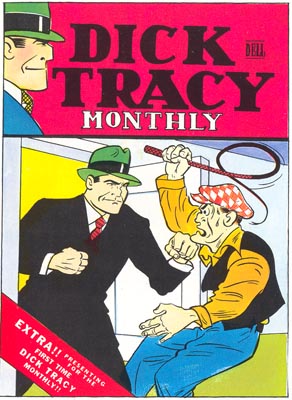 As someone born in the 1960s, I often feel like I lived the first half of my 40-odd years in one era and the other half in a different era. The pivot point, in my mind, was the proliferation of the personal computer in the 1980s. Just as Henry Ford’s Tin Lizzy fundamentally changed the way Americans (and much of the world) conducted their daily lives, PCs and Macs have dramatically changed both our personal and professional routines beyond all recognition. For young adults who were born in the 80s, I don’t think they can fully appreciate how different things used to be, just as I could hardly imagine my parent's world before television.
As someone born in the 1960s, I often feel like I lived the first half of my 40-odd years in one era and the other half in a different era. The pivot point, in my mind, was the proliferation of the personal computer in the 1980s. Just as Henry Ford’s Tin Lizzy fundamentally changed the way Americans (and much of the world) conducted their daily lives, PCs and Macs have dramatically changed both our personal and professional routines beyond all recognition. For young adults who were born in the 80s, I don’t think they can fully appreciate how different things used to be, just as I could hardly imagine my parent's world before television.One of the major changes since the 1980s is the eroding influence of newspapers. Of course, newspapers still exist, but there are far fewer than when I was a kid, and virtually all newspaper organizations now have a strong Internet presence which I would wager gets far more attention than their printed version. Cable and satellite news channels have also become the go-to outlets for instant news and information, relegating newspapers to a portable information product used when accessing a computer, Blackberry, cellphone with web access, or a television is not feasible. Information rushes at us from so many different sources, I don’t believe anyone seeks out one primary source any longer.
During my childhood, when the Internet was unheard of and television news was squeezed in between afternoon cartoons and the prime-time line-up, newspapers represented the main source of in-depth information and analysis, and most major cities had at least two newspapers fighting for your daily attention. Since the news was pretty much the same in both papers, they had to lure you with unique features. One such competitive feature was the comic strip page. Believe it or not, many people chose their source of news based on which paper had the best collection of comic strips. As a result, a popular comic strip was extremely important to newspapers and could be quite lucrative for both the syndication outfit and the comic strip producer.
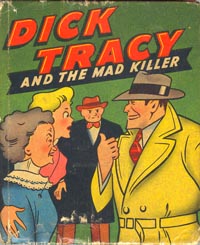 A handful of these popular strips have gone on to become cultural icons, like Dick Tracy. This gumshoe with the squared-off nose was a comic strip titan, drawing millions of readers every day for decades. Long before I came along, Dick Tracy’s popularity in newspapers spawned media spin-offs including movies, television shows, toys, comic books, and Big Little Books. The hard-boiled crime fighter, born in an era when G-Men were rounding up Depression-era gangsters, served as a cathartic outlet for those who felt anxious and helpless in an uncertain world. Once raised to the top of the entertainment heap, Dick Tracy retained his popular status into the 60s, before his creator Chester Gould made some inexplicable changes to the strip and snatched defeat from the jaws of victory.
A handful of these popular strips have gone on to become cultural icons, like Dick Tracy. This gumshoe with the squared-off nose was a comic strip titan, drawing millions of readers every day for decades. Long before I came along, Dick Tracy’s popularity in newspapers spawned media spin-offs including movies, television shows, toys, comic books, and Big Little Books. The hard-boiled crime fighter, born in an era when G-Men were rounding up Depression-era gangsters, served as a cathartic outlet for those who felt anxious and helpless in an uncertain world. Once raised to the top of the entertainment heap, Dick Tracy retained his popular status into the 60s, before his creator Chester Gould made some inexplicable changes to the strip and snatched defeat from the jaws of victory.
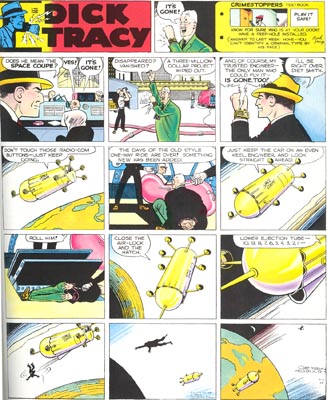 Given the strong interest in the space program, Chester Gould decided to give Dick Tracy a sci-fi angle with the introduction of the Space Coup. Soon,
Given the strong interest in the space program, Chester Gould decided to give Dick Tracy a sci-fi angle with the introduction of the Space Coup. Soon,
In my hometown, Dick Tracy appeared in The Baltimore Evening Sun. Again, no CNN or all-day Internet access, so many newspapers ran morning and evening editions. The other
In the 1970s, Dick Tracy was returning to his more gritty, police procedural formula, although he still had some futuristic gadgets like his two-way wrist t.v. and the hovering air cars in which the detective could zip around the city. At first, I didn’t realize that the strip ran daily, so I was confused why I couldn’t follow the plots simply by reading the Sunday edition. Once I figured out that we needed to receive the Evening Sun every day, I begged and pleaded with my parents to switch papers, but to no avail. Actually, I wanted them to receive both papers so I could continue to read
The day before I got my Sunday comics fix, I would watch Archie’s Famous Funnies, where popular comic strip characters were presented in short cartoon segments. Dick Tracy had a regular segment on the show, but it was entirely too short to develop any real plot. All it did was tease me with the desire for a full half-hour devoted only to Tracy and the gang. Weekday afternoons, the local stations would run an old Dick Tracy cartoon series from the 60s, but this series was played for laughs with
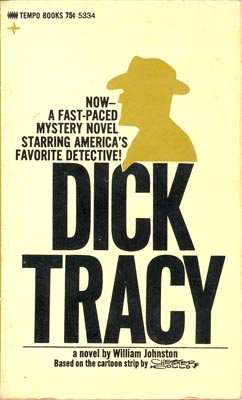 Slightly more interesting was a Big Little Book I got at the time called Dick Tracy Encounters Facey. I loved Big Little Books and this one dealt with a villain who could mold his face to look like other people including Tracy himself. I was so inspired by the book, I stapled together strips of paper about the same size as the Big Little Book and wrote my own adventure story in the same format. You remember: text on each left-hand page and an illustration on each right-hand page. I don’t recall the exact story, but the hero and heroine were named Rudy and Roxanne. Give me a break; I was eight years old.
Slightly more interesting was a Big Little Book I got at the time called Dick Tracy Encounters Facey. I loved Big Little Books and this one dealt with a villain who could mold his face to look like other people including Tracy himself. I was so inspired by the book, I stapled together strips of paper about the same size as the Big Little Book and wrote my own adventure story in the same format. You remember: text on each left-hand page and an illustration on each right-hand page. I don’t recall the exact story, but the hero and heroine were named Rudy and Roxanne. Give me a break; I was eight years old.
What really cemented my interest in the super cop was when my Dad brought home a big coffee-table type hardcover from the library which compiled all the daily and Sunday Tracy strips from the beginning in 1931 all the way into the 1940s.This was the detective in his prime and, after spending hours pouring over this huge collection, I felt like I really understood what Dick Tracy was all about. The wild, grotesque villains, the sadistic torture tests
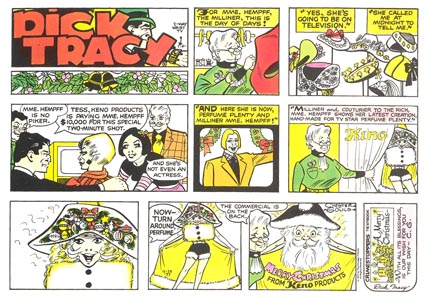 I continued to follow
I continued to follow
When the Dick Tracy movie came out in the summer of 1990, I decided to check back with my old detective friend. The News American had folded a few years prior, and The Sunpapers only published one edition in the morning. Dick Tracy had survived the comic strip layoffs and was appearing in the new morning edition. Art reflecting life, the story line during that summer dealt with




No comments:
Post a Comment